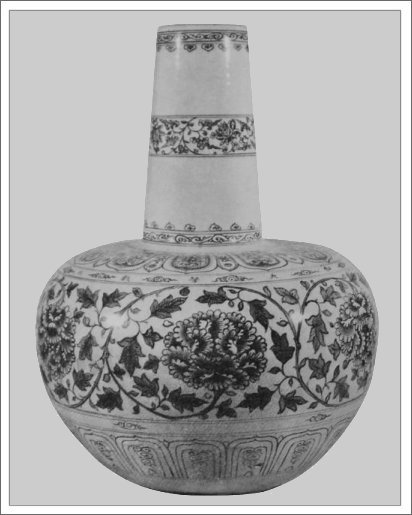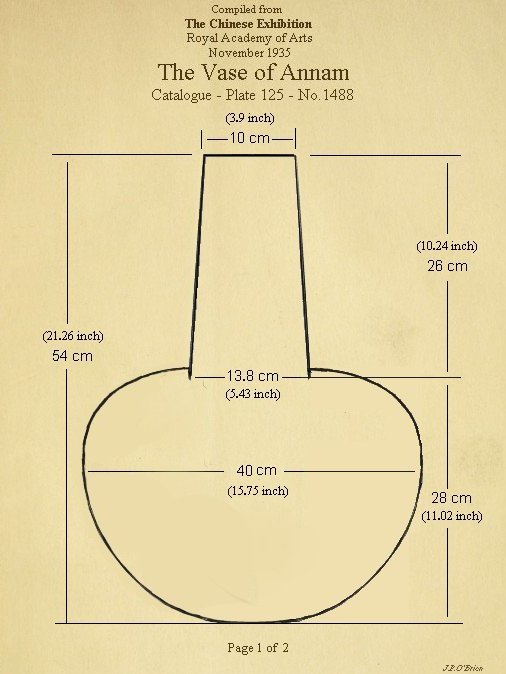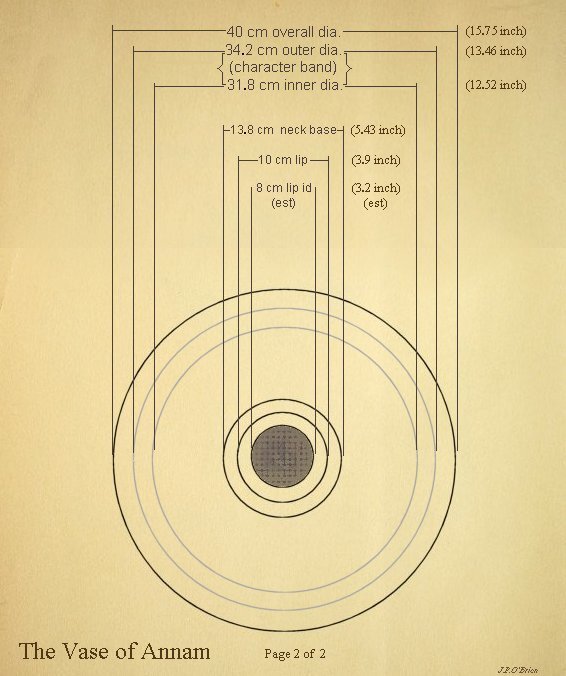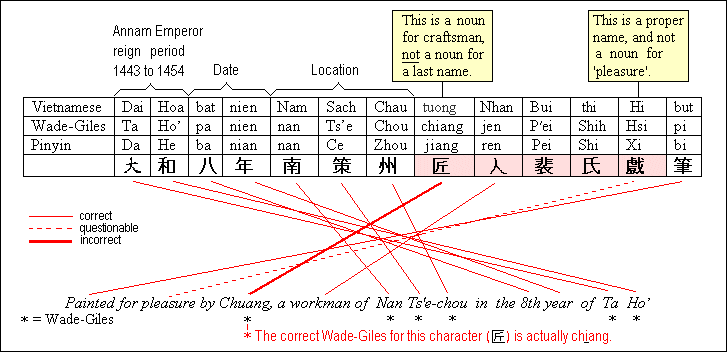|
. It's very difficult to challenge written history, but it is necessary at times. The tools we have today, as well as the increased spread of knowledge that accumulates as time marches on, tell us that we have to correct our mistakes. It shouldn't detract from, nor minimize, the contributions from the many fine scholars and dedicated people involved with the correction. They just didn't have the tools, or finds, that we are lucky to have today. This page will address such an issue, and will hopefully explain how it was a Vietnamese potter named Pei Shi Xi, and not a Chinese potter named Chuang, who painted the world famous Vase of Annam.This vase first came to the attention of the art world in 1933 when noted scholar R. L. Hobson discovered it in the Topkapi Sarayi Museum in Istanbul, Turkey. In his publication, he included the thirteen characters that encircled the shoulder, dating the vase to 1450 AD. Though he did not provide a photograph, he did provide the Chinese characters in text showing the sequence, along with the translation. This is the string he provided, with the translation (in Wade-Giles) just beneath it. .
Painted
for
pleasure by Chuang, a workman In his description of the vase, he described it as being exactly 54 centimeters in height. There seem to be few images available of the vase. In fact, I can only find two valid photos ever published. My own thoughts on this are that he was limited in access, and may not have been allowed enough time to perform a close examination, which of course would have included detailed photographs and measurements. Aside from the photograph provided by the Topkapi Museum, I have a second one from when it was on loan to the Royal Academy of Arts for the International Exhibition of Chinese Art in 1935. This is a quality black and white image similar to the Topkapi Museum image, differing only in the fact that the base is rotated approximately 75 degrees counter-clockwise. Here is that image. . Working with the known factor of 54 centimeters, and locating some of my old notes, I can provide the following measurements which should be fairly exact. This will show the true size and majesty of the vase. This, versus referring to it only as a large vase of 54cm in height, as most (if not all) publications do. The image, especially to Westerners who are not familiar with centimeters, gives the appearance that it could sit on a shelf or windowsill. Not quite so. Below will give a better idea as to its true size. . __________________
From the start though, the translation was in question. At one point it was decided the name of the workman was incorrect. Nonetheless, the translation reflecting Chuang was the one used for the Chinese Exhibition and it's subsequent publication in 1937. In a 1977 publication, The
Ceramics of
South-East Asia by Roxanna M. Brown, a
re-examination of the script identifies the 10th character, Pei It was in 1980 when the 10th,
11th, and 12th
characters I was not aware of the find, nor the claim, and only recently learned of it. I'm afraid being retired has removed me from current news in the world of Chinese art. If you are also unaware of the article, here is the link. It might be a good idea to look it over before reading further. Southeast Asian Archaeology Article . At first, I thought I'd put together just a brief page explaining why I support the revised translation. But considering the importance of the Annam vase, and to honor the true artisan that has been (until now) unknown, I've decided to go a little more in depth. And since I see there is still controversy, maybe some of my input will have impact on correcting what I feel was a mistranslation made almost 80 years ago regarding this important vase. And last, but not least, it should give credit to noted scholar Roxanna M. Brown who, in her 1977 publication, was perhaps the first to officially challenge the translation. Sadly she is no longer with us. Here we go...... Back in January of 1971, several years into my Chinese study, my mother presented me with a very fine book, The Chinese Exhibition - Faber & Faber, 1937 publication. Though my interest and study focused more on Chinese history and calligraphy at the time, it was my first introduction to the famous Vase of Annam. My interest in calligraphy brought even closer attention to the inscription. What
bothered me
about the accepted translation was that it seemed broken in the string
(or flow), and it puzzled me that there was no mention or referral
(going left to right) to three characters in the string, the
10th, 11th, and 12th, At the time, my focus was more on China, and not Vietnam (previously Annam), so I didn't investigate it further. When it was announced (almost 40 years later) that a Vietnamese family claimed their ancestor, a woman named Bui thi Hi (Vietnamese pronunciation) painted the vase, it provided the missing link (for me at least). It made the string run smoothly together, in sequence from left to right. It explained perfectly the three missing characters that I questioned many years ago, but didn't have the answer to. Here, in the same order, is the Vietnamese phonetic translation of the character string. Vietnamese (phonetic association) Regardless
of the
almost unquestionable data that has now surfaced, it surprises me that
there is still an ongoing debate regarding the translation. And it
seems oddly to have focused on Xi . Original Translation . This next
table reflects
the
changes in showing Jiang . Revised Translation . Now
that we know the true name of the artisan is Pei Shi Xi
He
didn't go far. In fact he still fits perfectly in the string
as a noun, but not a proper noun. Jiang Since the characters circle the
neck, the
starting
point could be other than Ta Perhaps the lack of photos for the vase has
contributed to the mistranslation over the years. Between the two
photographs I have, only seven characters are clearly recognizable,
three are not clear, and three characters, Jiang JP
. .
|






